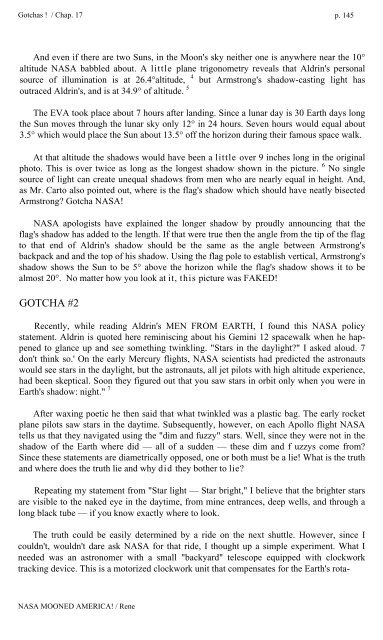Rene-NASA-Mooned-America
Rene-NASA-Mooned-America
Rene-NASA-Mooned-America
Create successful ePaper yourself
Turn your PDF publications into a flip-book with our unique Google optimized e-Paper software.
Gotchas ! / Chap. 17 p. 145<br />
And even if there are two Suns, in the Moon's sky neither one is anywhere near the 10°<br />
altitude <strong>NASA</strong> babbled about. A little plane trigonometry reveals that Aldrin's personal<br />
source of illumination is at 26.4°altitude, 4 but Armstrong's shadow-casting light has<br />
outraced Aldrin's, and is at 34.9° of altitude. 5<br />
The EVA took place about 7 hours after landing. Since a lunar day is 30 Earth days long<br />
the Sun moves through the lunar sky only 12° in 24 hours. Seven hours would equal about<br />
3.5° which would place the Sun about 13.5° off the horizon during their famous space walk.<br />
At that altitude the shadows would have been a little over 9 inches long in the original<br />
photo. This is over twice as long as the longest shadow shown in the picture. 6 No single<br />
source of light can create unequal shadows from men who are nearly equal in height. And,<br />
as Mr. Carto also pointed out, where is the flag's shadow which should have neatly bisected<br />
Armstrong Gotcha <strong>NASA</strong>!<br />
<strong>NASA</strong> apologists have explained the longer shadow by proudly announcing that the<br />
flag's shadow has added to the length. If that were true then the angle from the tip of the flag<br />
to that end of Aldrin's shadow should be the same as the angle between Armstrong's<br />
backpack and and the top of his shadow. Using the flag pole to establish vertical, Armstrong's<br />
shadow shows the Sun to be 5° above the horizon while the flag's shadow shows it to be<br />
almost 20°. No matter how you look at it, this picture was FAKED!<br />
GOTCHA #2<br />
Recently, while reading Aldrin's MEN FROM EARTH, I found this <strong>NASA</strong> policy<br />
statement. Aldrin is quoted here reminiscing about his Gemini 12 spacewalk when he happened<br />
to glance up and see something twinkling. "Stars in the daylight" I asked aloud. 7<br />
don't think so.' On the early Mercury flights, <strong>NASA</strong> scientists had predicted the astronauts<br />
would see stars in the daylight, but the astronauts, all jet pilots with high altitude experience,<br />
had been skeptical. Soon they figured out that you saw stars in orbit only when you were in<br />
Earth's shadow: night." 7<br />
After waxing poetic he then said that what twinkled was a plastic bag. The early rocket<br />
plane pilots saw stars in the daytime. Subsequently, however, on each Apollo flight <strong>NASA</strong><br />
tells us that they navigated using the "dim and fuzzy" stars. Well, since they were not in the<br />
shadow of the Earth where did — all of a sudden — these dim and f uzzys come from<br />
Since these statements are diametrically opposed, one or both must be a lie! What is the truth<br />
and where does the truth lie and why did they bother to lie<br />
Repeating my statement from "Star light — Star bright," I believe that the brighter stars<br />
are visible to the naked eye in the daytime, from mine entrances, deep wells, and through a<br />
long black tube — if you know exactly where to look.<br />
The truth could be easily determined by a ride on the next shuttle. However, since I<br />
couldn't, wouldn't dare ask <strong>NASA</strong> for that ride, I thought up a simple experiment. What I<br />
needed was an astronomer with a small "backyard" telescope equipped with clockwork<br />
tracking device. This is a motorized clockwork unit that compensates for the Earth's rota-<br />
<strong>NASA</strong> MOONED AMERICA! / <strong>Rene</strong>


